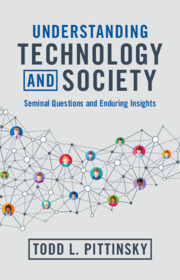Refine search
Actions for selected content:
593 results
3 - ‘The Glory of their times’: Natural Philosophy, the Law, and the Spoils of Empire
-
- Book:
- The University of Cambridge in the Age of Atlantic Slavery
- Published online:
- 12 September 2025
- Print publication:
- 30 October 2025, pp 76-103
-
- Chapter
-
- You have access
- Open access
- HTML
- Export citation
Chapter 4 - Bloomsbury and the New Biography
- from Part I - Aesthetic Bloomsbury
-
-
- Book:
- A History of the Bloomsbury Group
- Published online:
- 09 October 2025
- Print publication:
- 23 October 2025, pp 52-67
-
- Chapter
- Export citation
Introduction
-
-
- Book:
- Science and Humanism
- Published online:
- 09 October 2025
- Print publication:
- 23 October 2025, pp 1-8
-
- Chapter
-
- You have access
- Open access
- HTML
- Export citation
Chapter 23 - Bloomsbury and Science
- from Part IV - Public Bloomsbury
-
-
- Book:
- A History of the Bloomsbury Group
- Published online:
- 09 October 2025
- Print publication:
- 23 October 2025, pp 383-398
-
- Chapter
- Export citation
Chapter 2 - Varieties of Philosophical Humanism and Conceptions of Science
- from Part I - Interrelations
-
-
- Book:
- Science and Humanism
- Published online:
- 09 October 2025
- Print publication:
- 23 October 2025, pp 36-59
-
- Chapter
-
- You have access
- Open access
- HTML
- Export citation
Chapter 1 - What Is Science For?
- from Part I - Interrelations
-
-
- Book:
- Science and Humanism
- Published online:
- 09 October 2025
- Print publication:
- 23 October 2025, pp 11-35
-
- Chapter
-
- You have access
- Open access
- HTML
- Export citation
21 - Medical and Scientific Writing
- from Part III - Genre and Medium in the Record
-
-
- Book:
- The New Cambridge History of the English Language
- Print publication:
- 16 October 2025, pp 506-533
-
- Chapter
- Export citation
Chapter 4 - Empiricism and Kantian Accounts of Thought Experiment
- from Part I - The Origins of “Thought Experiment” in Kant and Ørsted
-
- Book:
- Kierkegaard and the Structure of Imagination
- Published online:
- 26 September 2025
- Print publication:
- 16 October 2025, pp 63-75
-
- Chapter
- Export citation

Science and Humanism
- Knowledge, Values, and the Common Good
-
- Published online:
- 09 October 2025
- Print publication:
- 23 October 2025
-
- Book
-
- You have access
- Open access
- Export citation
Conclusion
-
- Book:
- Risk and Resistance
- Published online:
- 10 September 2025
- Print publication:
- 09 October 2025, pp 145-151
-
- Chapter
- Export citation
6 - Knowledge, Technology Transfer and Convergence
-
- Book:
- An Economic History of Europe
- Published online:
- 02 October 2025
- Print publication:
- 02 October 2025, pp 132-154
-
- Chapter
- Export citation

Understanding Technology and Society
- Seminal Questions and Enduring Insights
-
- Published online:
- 30 September 2025
- Print publication:
- 10 July 2025
Chapter 10 - Theory of Demonstration
-
-
- Book:
- Ockham’s <i>Summa Logicae</i>
- Published online:
- 04 September 2025
- Print publication:
- 18 September 2025, pp 210-230
-
- Chapter
- Export citation
Chapter 11 - Synge, Modernity, and the Myth of Revival
- from Part III - Mythologies of the Literary Revival
-
-
- Book:
- The Revival in Irish Literature and Culture
- Published online:
- 04 September 2025
- Print publication:
- 18 September 2025, pp 222-238
-
- Chapter
- Export citation
Chapter 10 - Science
- from Part II - Themes and Issues
-
-
- Book:
- The Cambridge Companion to Modernist Theatre
- Published online:
- 28 August 2025
- Print publication:
- 11 September 2025, pp 180-197
-
- Chapter
- Export citation
Undergraduate student attitudes towards animal welfare science: An investigation to inform teaching approaches
-
- Journal:
- Animal Welfare / Volume 34 / 2025
- Published online by Cambridge University Press:
- 19 August 2025, e58
-
- Article
-
- You have access
- Open access
- HTML
- Export citation
Chapter 6 - The World Is a Book
-
- Book:
- How the World Became a Book in Shakespeare's England
- Published online:
- 09 August 2025
- Print publication:
- 14 August 2025, pp 191-233
-
- Chapter
- Export citation
Chapter 9 - Integration and general capabilities
- from Part 3 - How: Embedding the Arts in education
-
- Book:
- Teaching the Arts
- Published online:
- 28 July 2025
- Print publication:
- 06 August 2025, pp 280-302
-
- Chapter
- Export citation

Human Cognitive Diversity
-
- Published online:
- 05 August 2025
- Print publication:
- 04 September 2025
-
- Element
- Export citation
14 - Theories and Some Implications
-
- Book:
- Innovation Management
- Published online:
- 06 June 2025
- Print publication:
- 10 July 2025, pp 210-216
-
- Chapter
- Export citation
